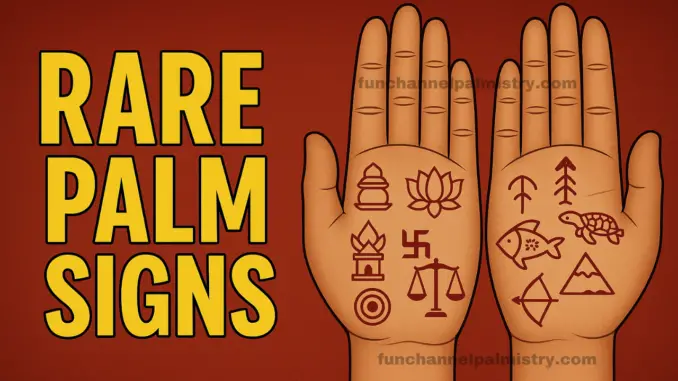
Difference between Cheirognomy and Cheirognomy
Cheirognomy refers to the study of the shape and structure of the hand, including the fingers, palm, nails, and overall form. It is based on the belief that a person’s character and temperament can be determined by the physical attributes of their hands.
Cheiromancy commonly known as palmistry involves the interpretation of palm lines to predict the future, past, and present events and reveal insights about a person’s life, including love, career, and destiny.
Cheirognomy comes before Cheiromancy— but why?
Cheirognomy serves as the foundation for understanding an individual’s personality and character. Think of it as a car’s engine; without it, the entire mechanism can’t function. If a person’s core traits are flawed, it indicates that there is room for improvement and transformation.
Without addressing negative personality traits or making a conscious effort to change, the lines on the palm will take a long time to change or will not change at all. This is because the neural pathways in the hand are directly connected to the brain, reflecting an individual’s thought process. It is as straightforward as that.
Many people skip Cheirognomy and jump straight into Cheiromancy because it appears easier and requires less mental effort. However, this often leads to inaccurate readings and serious misinterpretations.
True mastery of palmistry requires the combined knowledge of Chirognomy and Chiromancy. This demands a high level of critical thinking, deep analysis, and the ability to connect intricate details to derive meaningful conclusions. Only a few dedicated professional palm readers attain this level of expertise.
The rest? They remain amateurs and wannabes. 99% of the readers belong to this category. This serves as a reality check for those who dismiss palm reading as mere superstition. The truth is, they lack the skill and understanding to read it correctly.
Various Forms Of Palmistry
Palmistry is practiced in various forms across the world.
For instance, there is Western palmistry, Hindu palmistry, the Five Element system, Chinese palmistry, and several others. Each tradition carries its unique interpretations, yet over time, they have borrowed concepts from one another, shaping a more evolved understanding of hand reading.
Having studied multiple forms of palmistry, I have observed that each system contains both valuable insights and impractical nonsensical theories. My approach is to extract the practical, time-tested principles from each, discard the illogical ones, and refine my understanding based on extensive real-world experience having read thousands upon thousands of palms from different countries and ethnicities.
The only way to validate a theory is to test it across a large sample size. However, this requires deep knowledge and expertise in palmistry from the very beginning.
Unfortunately, many readers allow ultra-nationalistic biases to cloud their judgment. They rigidly adhere to one form of palmistry often due to cultural ties while disregarding the rest. In doing so, they deceive themselves and limit their ability to become truly skilled readers.
Palmistry, like any field, must evolve with time. As technology and human behavior change, certain ancient theories become obsolete. To remain relevant and accurate, palm readers must adapt, continuously refining their knowledge rather than clinging to outdated concepts.
Hypothesis behind Hindu palmistry signs
In Western palmistry, there are about five to six commonly recognized symbols considered auspicious provided they are well-formed and free from defects.
These include the triangle, square, star, trident, and single vertical line, among others.
Hindu palmistry, however, greatly expands this list, incorporating a vast array of symbols such as the fish sign, conch, swastika, temple, pot, lotus, hill, arrow, and many more, in addition to those acknowledged in Western traditions.
A closer look reveals that many of these symbols originate from historical dynasties and bear deep cultural significance within Hinduism. Ancient palmists documented what they observed in their surroundings, recording these signs in scriptures as a means of interpreting destiny and wealth.
In this article, I will cover some of these symbols, while others, frankly speaking, are impractical and better left within the pages of old texts rather than applied to real-world palm readings.
As for the so-called “auspicious” symbols in Chinese palmistry, I have found them to be largely unreliable in actual palm readings. However, for the sake of information, I may explore them in another article.
I must emphasize again that symbols alone hold little value if the overall hand structure and other key parameters are not analyzed in conjunction. A well-marked sign on a weak or imbalanced hand does not have that significance or doesn’t get activated to its true potential.
With that in mind, let’s explore the different auspicious symbols in Hindu palmistry.
Wheel sign in palmistry
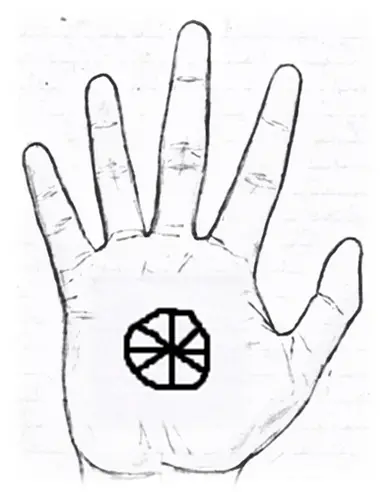
The wheel sign in palmistry represents great authority, destiny-driven success, and control over one’s domain.
The wheel itself represents movement, progress, and the cycle of destiny, which suggests that those with this mark are meant for greatness, continuously advancing toward higher achievements and societal impact.
Spearhead sign in palmistry
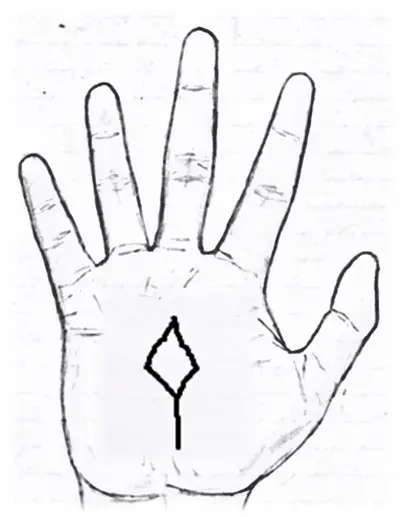
Historically, spearheads were weapons of protection, used to defend kingdoms from enemies. The sign represents triumph, resilience, and the ability to conquer challenges in life.
The presence of a spearhead sign on the palm denotes a strong drive to overcome obstacles and emerge victorious. Any effort or hard work put in by the bearer will ultimately lead to success and achievement.
Moon sign in palmistry
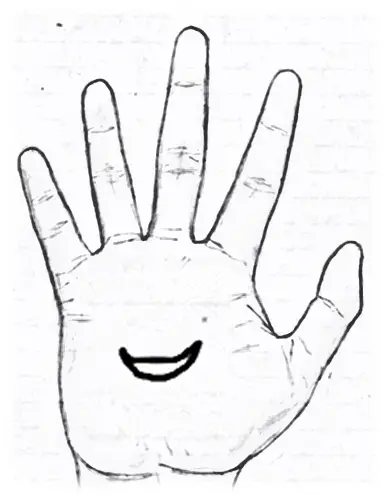
If the moon sign is found on the hand as shown, it suggests that the bearer is destined to rise to a high-ranking position. They will enjoy respect, recognition, and authority in their professional life.
Such a person is gentle, emotionally mature, composed, and maintains a balanced demeanor even in challenging situations. They will be deeply respected for their graceful conduct and benevolent heart.
Read More: If you have Guardian Angel Line, consider yourself very lucky, CLICK HERE
Temple sign in palmistry
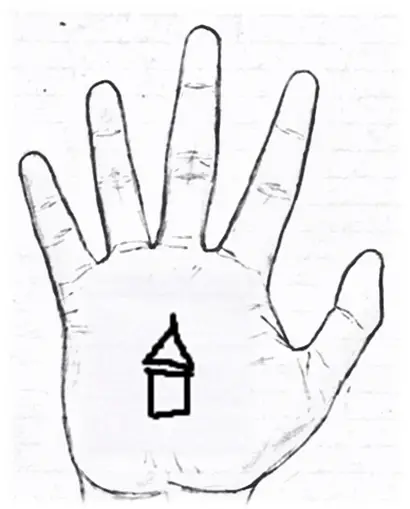
The temple sign in palmistry is an extremely rare and highly auspicious marking. It bestows the person with deep spiritual wisdom, a solid moral character, divine blessings, and a life of effortless success.
It acts as a protective shield, safeguarding the bearer from serious misfortunes and obstacles in life.
I have seen this sign on renowned social workers and religious leaders who dedicated their lives to uplifting others while enjoying divine grace, higher consciousness, and worldly success.
Arrow sign in palmistry

If a sign of an arrow is found on the hand as shown indicates the bearer is gifted with excellent communication skills.
The bearer having such a sign has the potential to achieve anything in life using one’s oratory skills as he or she knows when to hit the right opportunity.
A sign of an arrow can be found anywhere on the hand but generally gets spotted on the mount of mercury.
Scale sign in palmistry
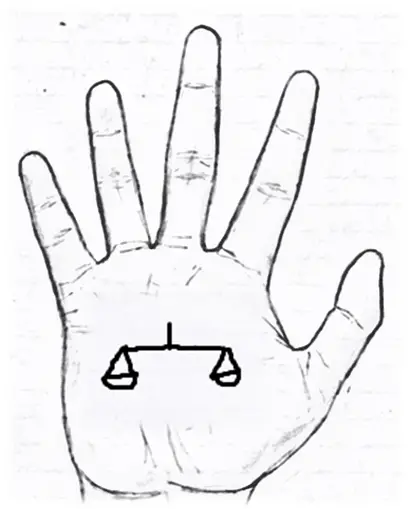
The scale is a universal symbol of justice, balance, and fair judgment, often associated with wisdom, law, and commerce.
A person with this mark possesses strong analytical skills, impartiality, and a natural ability to weigh both sides of a situation before arriving at a just conclusion, making them trusted advisors, mediators, or judges in various aspects of life.
Since Saturn is regarded as the balancing force in palmistry as it balances and maintains equilibrium between various aspects of the palm, this sign is often found on the Mount of Saturn, further reinforcing the individual’s ability to maintain stability in all aspects of life. However, depending on the person’s unique destiny and strengths, it can also appear elsewhere on the palm.
Read More: Types of Sun lines, CLICK HERE
Whorl sign in palmistry
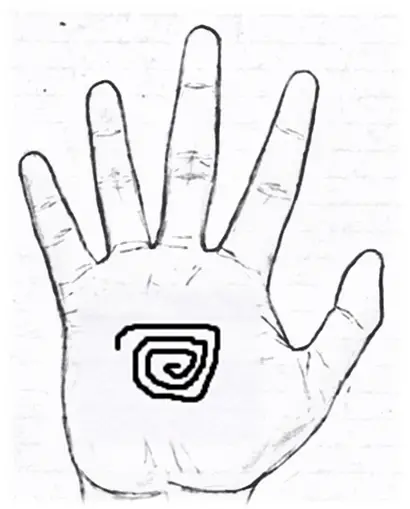
A whorl-like formation in palmistry suggests that the bearer possesses rare skills or knowledge that set them apart from the average person.
People with whorl signs are often original thinkers, highly independent, and tend to challenge societal norms or conventional systems. They have a strong need for personal freedom and dislike interference in their personal space or decisions. Their minds are wired to question, explore, and innovate rather than follow the beaten path.
Whorls typically appear at the fingertips, but can also be found on the mounts of the palm especially on the mount of Moon and the mount of Venus.
The location of the whorl can offer deeper insights. For example, the whorl on the Apollo finger indicates creative brilliance and often seen on the hands of artists, performers, designers, or those in creative industries.
Similarly, the whorl on the Mercury’s finger points to natural aptitude in research, psychology, investigation, and sales.
However, it’s important to note that whorl-bearers often experience a sense of isolation or loneliness, not because they are anti-social, but because of their intense drive for self-mastery and perfection. Their obsession with growth and refinement can sometimes detach them from the world around them.
Tortoise sign in palmistry
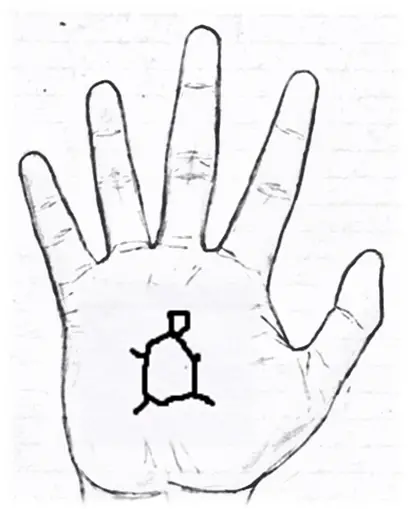
The tortoise sign in palmistry indicates a life filled with unexpected fortune and prosperity and is considered an extremely lucky symbol.
The tortoise has long been associated with stability, longevity, and wisdom. A person with this sign tends to attract abundant opportunities effortlessly and they may experience sudden wealth or financial windfalls at some point in life.
House sign in palmistry

In palmistry, the house sign is relatively rare.
Just as a house offers shelter and protection, the presence of this sign on the palm indicates someone likely to build a secure and prosperous life, both materially and emotionally.
They have a natural talent for real estate, architecture, or managing domestic affairs with great efficiency acting as a pillar of support for their loved ones.
Goat sign in palmistry

The goat sign in palmistry is considered a symbol of good fortune, persistence, and sudden financial gains in high-stakes investing or speculative ventures.
The goat, by nature, is tenacious, adaptable, and sure-footed, often climbing rocky paths with ease. Similarly, individuals with this sign tend to navigate risky situations through a mix of intuition, courage, and sheer luck. Check other rare auspicious symbols in this article.

Be the first to comment